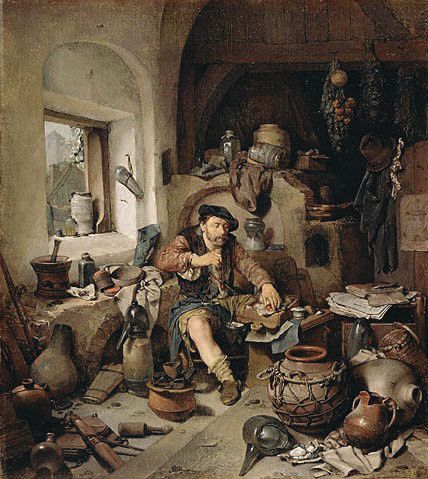Unlocking ancient mysteries
Dr. Maureen Hunter | TLT President's Report February 2015
Alchemists learned about and developed some of our industry’s greatest secrets.

Cornelis Pietersz Bega’s 1663 painting The Alchemist can be seen at the J. Paul Getty Museum in Los Angeles. J. Paul Getty founded the Getty Oil Company.
APPEARANCES CAN BE DECEIVING. Down a short dark hallway in a somewhat remote part of my house hangs a framed print. My husband has had it since he was an undergraduate chemistry student. It’s a copy of Cornelis Pietersz Bega’s 1663 painting called The Alchemist.
Sometimes I find myself standing in front of it, transported back in time. The light pouring in through the painting’s open window shows off the textures and surfaces of the assorted cracked clay and glass vessels. And the unkempt medieval alchemist, oblivious to his cluttered surroundings, weighs out a substance for one of his experiments in creating the philosophers’ stone, a legendary substance that reputedly could turn base metals like lead into gold.
The painting is Bega’s statement about time wasted on materialistic and futile pursuits. But was it really wasted time? I don’t think so. For centuries some of the world’s greatest geniuses (including Isaac Newton, Robert Boyle and Nicolas Flamel) toiled and tinkered in the laboratory to turn base metals into gold and silver. And in their restless quest, they unlocked some of our industry’s greatest secrets.
Alchemy in the western world started in Alexandria, Egypt, in the third century A.D. when the Greek word
chemia referred to the refining of metals and the making of alloys, including those that mimicked gold and silver.
Chemia means to melt, smelt or cast. So you could say that the origins of alchemy, that is, the origins of chemistry, come from a metalworking tradition.
Alchemists developed laboratory techniques, theories, terminologies and experimental methodologies that are still in use today. They learned how to test ore and extract metals from it. They learned metalworking techniques and how to make new alloys. They learned how to perform distillations, crystallizations and sublimations. They worked to improve instruments and glass blowing. They described and cataloged substances leading to the first rudimentary periodic tables. They learned how to produce inks, dyes, pigments, paints, cosmetics, ceramics, acids, bases and medicines as well. Many alchemists also searched for the elixir of immortality and, in the process, identified remedies to heal wounds and increase good health.
Even with all these contributions, we sometimes like to scoff at the alchemists for their long search for the secret of transmutation. Though they missed the mark, when you think about it they weren’t too far off in theory. Radioactive decay, which happens all the time in nature, realizes the dream of the alchemists to transform one element into another. It won’t turn lead into gold, but alpha decay will move an element two steps down in the periodic table, and beta decay will move it up or down one step.
In fact, in our modern times, beta decay is used to uncover forgeries or augmentations in paintings, often medieval ones. No one would ever test my husband’s inexpensive print, but for a famous painting in question, this is done by bombarding free neutrons into the painting. When the neutrons combine with the nuclei of atoms in the pigments, they transform those atoms into the radioactive isotopes of the element one step up in the periodic table. (Remember that a neutron becomes a proton, an electron and an antineutrino. And an extra proton makes a different element.) Then the excited isotopes decay on predictable timescales telling which elements were used in the pigments. And because various pigments were made using different elements throughout time and by different artists, forgeries can easily be detected.
When I look at Bega’s painting, I don’t see time wasted on futile pursuits. I see a medieval alchemist struggling with fundamental questions. In an age when there was not even a microscope, I see a scientist doing his best to make sense of a world he could not see. In pursuing what today might seem like little more than witchcraft, the alchemists foreshadowed the thinking that would emerge centuries later during the Scientific Revolution and become central to today’s fields of chemistry and physics.
 Maureen Hunter is the technical service manager for King Industries, Inc., in Norwalk, Conn. You can reach her at mhunter@kingindustries.com
Maureen Hunter is the technical service manager for King Industries, Inc., in Norwalk, Conn. You can reach her at mhunter@kingindustries.com.